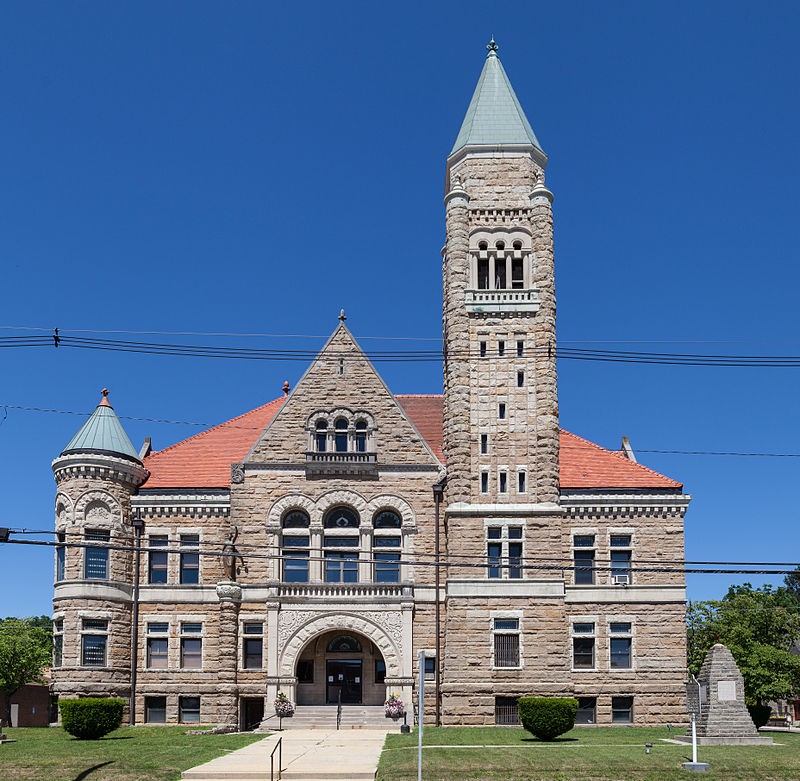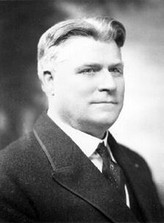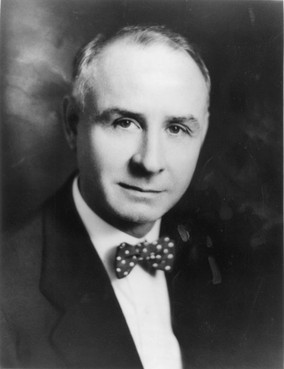Randolph County Courthouse
Introduction
Text-to-speech Audio
Images
Current photo of Randolph County Courthouse.

Ephraim F. Morgan, who practiced law at the Randolph County Courthouse shortly after its construction.

Herman Guy Kump, West Virginia governor and resident of Elkins.

Backstory and Context
Text-to-speech Audio
The Randolph County Courthouse in Elkins, West Virginia was a center of local controversy before it even existed. When the county was founded as part of the state of Virginia in 1787, the town of Beverly seven miles to the south of modern-day Elkins was the most prominent community in the area and thus became the county seat. That seat’s regional prominence grew over the course of the early nineteenth century as a result of the Staunton-Parkersburg Turnpike, which Beverly’s residents convinced state authorities to construct on an indirect route that hooked northward to bring business through their town. In the second half of the nineteenth century, however, railroad activity quickly outpaced turnpike travel, and Beverly’s economy and demographic growth began to stagnate. The population and trade of Elkins, on the other hand, expanded rapidly after its foundation in 1890 as a town specifically intended to service the West Virginia Central and Pittsburgh Railroad, and with the backing of its founders Senators Stephen B. Elkins and Henry Gassaway Davis soon eclipsed Beverly in regional influence. In response to this shift the citizens of Elkins began efforts to move the county seat from Beverly, efforts that resulted in rising tensions between the two communities that are known locally as the “Randolph County Courthouse Wars.” Ultimately, this conflict was resolved in the courts in 1898 in Elkins’ favor and plans moved forward for the construction of a new county courthouse.
After several years of planning, construction began under the direction of Uniontown, Pennsylvania architect John Charles Fulton in 1902. Fulton, a prominent Pittsburgh-area architect who played a role in the construction of a number of courthouses throughout the state (among them those of Doddridge County, Barbour County, and Monongalia County), designed the Randolph County Courthouse in the style popularized by Henry Hobson Richardson during the late nineteenth century. Richardson, recognized along with Louis Sullivan and Frank Lloyd Wright as one of the three most influential architects in American history, is perhaps best known for his work on Trinity Church in Boston’s Back Bay. Like that building, the Randolph County Courthouse features prominent rounded arches, a recessed entryway, contrasting masonry textures, and towers with conical caps, characteristics borrowed from Roman and Byzantine buildings that came to define Richardson’s work and the Richardsonian Romanesque architectural style named for him. While examples of that style can be seen across the United States, however, it largely failed to take hold in West Virginia. Only a few dozen public and private structures were built with its features and of those the Randolph County Courthouse is among the most prominent, making it a unique architectural contribution to the region.
The courthouse is equally unique as a site with connections to prominent individuals from the state’s history. Two future West Virginia governors practiced law there in its first year in operation. The first, Ephraim F. Morgan, was the Republican Party’s candidate in the gubernatorial race of 1920 and after winning with a plurality of the vote served as head of the state from 1921 to 1925. A descendent of prominent early colonist to western Virginia Morgan Morgan and native of Marion County, West Virginia, Ephraim Morgan ran as a pro-business candidate in one of the most hotly contested elections in the state’s history. In that election, Morgan received less votes than the combined total earned by pro-labor candidate Samuel B. Montgomery and Socialist Matthew S. Holt, but because his opposition was split between those two candidates and Democrat Arthur B. Koontz he was able to eke out a narrow victory. During the campaign Morgan had run as an opponent of labor unions in the state and friend to the coal mining industry, and his term as governor was largely reflective of those priorities. Morgan’s opposition to the United Mine Workers of America resulted in an escalation of the West Virginia Mine Wars, a series of increasingly violent conflicts between unionized mine workers and mining industrialists backed by government troops and armed vigilantes. Eventually, after repeated requests from Morgan, President Warren G. Harding dispatched federal troops to intervene in the conflict, an action that prompted a series of court cases that ultimately bankrupted UMWA.
The second West Virginia governor to practice law in the Randolph County Courthouse in its first year of existence, Herman G. Kump, was considerably less conservative than his predecessor. After winning the 1932 election as part of the political wave that brought Democrats to office across the United States in response to the Republican Party’s slow response to the Great Depression, Kump was the first member of his party to lead the state since 1894. Although he endorsed the party’s presidential nominee Franklin D. Roosevelt, however, Kump failed in many respects to endorse the policies of Roosevelt’s New Deal. While he worked to salvage the state’s depleted treasury with a series of tax increases that ultimately increased the state government’s authority over local affairs and unintentionally paved the way for later New Deal reforms, Kump opposed any expansion to the welfare system and endeavored to curtail the influence of labor unions. The growing conflict Kump’s fiscal conservatism prompted between his supporters (known as “Statehouse Democrats”) and New Deal Democrats culminated in the election of the more progressive Matthew M. Neely, which cemented an alliance between the Democratic Party and labor unionists that dominated state politics for the rest of the century.
Through its connections to two of the most prominent governors of West Virginia in the first half of the twentieth century and its status as an example of Richardsonian Romanesque architecture, the Randolph County Courthouse serves as a window into some of the most impactful processes in the history of West Virginia and the United States. As a product of the Randolph County Courthouse Wars of the late nineteenth century, the structure is also a unique testament to the progress of local and regional affairs during the same period. With a little bit of something for everyone, the building is thus a must-see during any visit to the city of Elkins.
Sources
Bosworth, Albert Squire. A History of Randolph County, West Virginia, from Its Earliest Exploration and Settlement to the Present Time. Elkins, WV, 1916.
Hennen, John. "Ephraim Franklin Morgan." The West Virginia Encyclopedia.May 16, 2016. Accessed August 20, 2019. https://www.wvencyclopedia.org/articles/2046.
Rensselaer, Mariana Grinswold Van. Henry Hobson Richardson and His Works. New York: Dover, 1969.
Thomas, Jerry Bruce. "Herman Guy Kump." The West Virginia Encyclopedia.May 16, 2016. Accessed August 20, 2019. https://www.wvencyclopedia.org/articles/1262.
Wikipedia
Wikipedia
The West Virginia Encyclopedia
